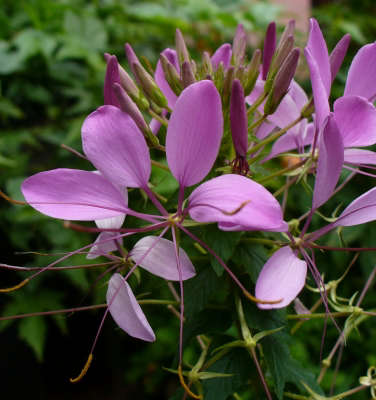

Cleome is a late-summer stalwart that will add pink and white color to the back of a garden border after other annuals have started to flag. Plant it in full sun and well-drained soil and spider flower will thrive.
The great gardening writer Henry Mitchell (perhaps you’ve stumbled across a compendium of his “Earthman” newspaper columns) once asked: “I wonder if anybody ever planned a garden to be at its best the first week of September?”
Why not be that gardener? If you plant cleome seedlings in late June, your flower beds will have a riot of pink and white puffballs well beyond Labor Day. Cleome hassleriana is an annual that thrives in hot temperatures (it’s a native of South America and the West Indies) and will reach heights of from three to five feet in the back of the border. Our contributor Jeanne Rostaing notes that cleome “is unfazed by sunstroke-level heat” and in a sunny spot is an excellent companion to zinnias, cosmos, sunflowers, black-eyed Susans, and dahlias.
After it gets established, cleome is drought tolerant (especially if dressed with a layer of organic mulch) and will grow in virtually any type of soil as long as it has good drainage. Grow it as an annual unless you live in USDA zones 10 or 11.
v5.0
When you register as a free Member of the Remodelista family of websites (Remodelista, Gardenista, and The Organized Home), you gain access to all current posts plus 10 archived posts per month, our internal bookmarking tool, and the community bulletin board.
Member benefits include:
For $5/month ($59.99 paid annually) you'll enjoy unlimited, ad-free access to Remodelista, Gardenista, and The Organized Home and all the benefits of Membership.
Subscriber benefits include:
For $5/month ($59.99 paid annually) you'll enjoy unlimited, ad-free access to Remodelista, Gardenista, and The Organized Home and all the benefits of Membership.
Subscriber benefits include:
Benefits include:
For $5/month ($59.99 paid annually) you'll enjoy unlimited, ad-free access to Remodelista, Gardenista, and The Organized Home and all the benefits of Membership.
Subscriber benefits include:
When you register as a free Member of the Remodelista family of websites (Remodelista, Gardenista, and The Organized Home), you gain access to all current posts plus 10 archived posts per month, our internal bookmarking tool, and the community bulletin board.
Member benefits include:
If at any time you want to become a Subscriber and enjoy unlimited, ad-free access to all our content, just go to the My Account link and choose Subscribe.
Advertising funds our work at Gardenista and helps us provide you with a daily dose of garden inspiration & design. We hope you’ll consider disabling your adblocker for Gardenista so we can continue our mission: a well-designed garden for all.
Thank you for your support.